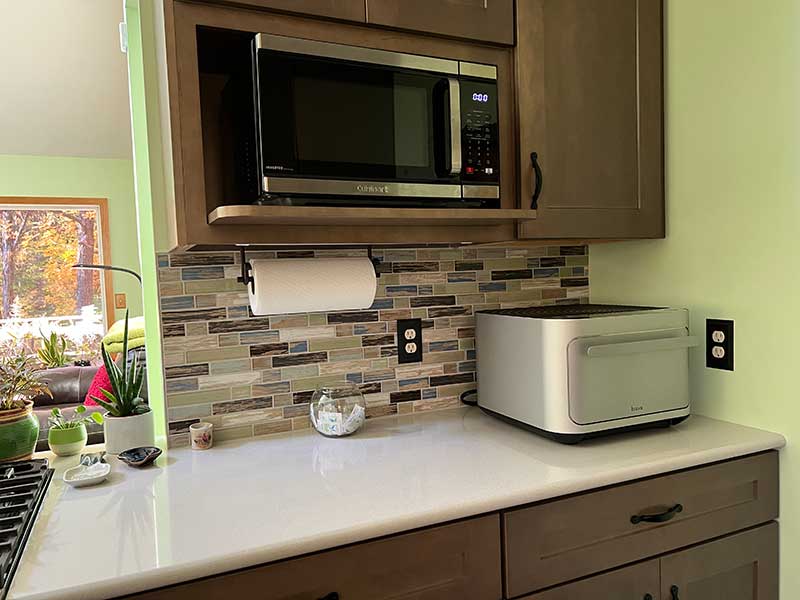
REVIEW – Cooking healthy food can be a challenge when life is busy and your cooking skill level isn’t on par with Gordon Ramsay. What if there was a smart countertop cooking device that could lead you step by step in the cooking process to cook your food to perfection? There is and it’s called the Brava. It’s awesome but it’s not without a couple of caveats. Let’s take a look.
What is it?
Brava is a smart cooking device that uses high-powered light bulbs to cook a whole meal on one tray even if they are entirely different types of foods like meat and vegetables. It also has built-in recipes and instructions that will lead you by the hand (spoon?) to bake, cook, air fry, dehydrate, and reheat your leftovers. It can effectively replace your oven, air fryer, dehydrator, slow cooker, and microwave.
What’s in the box?
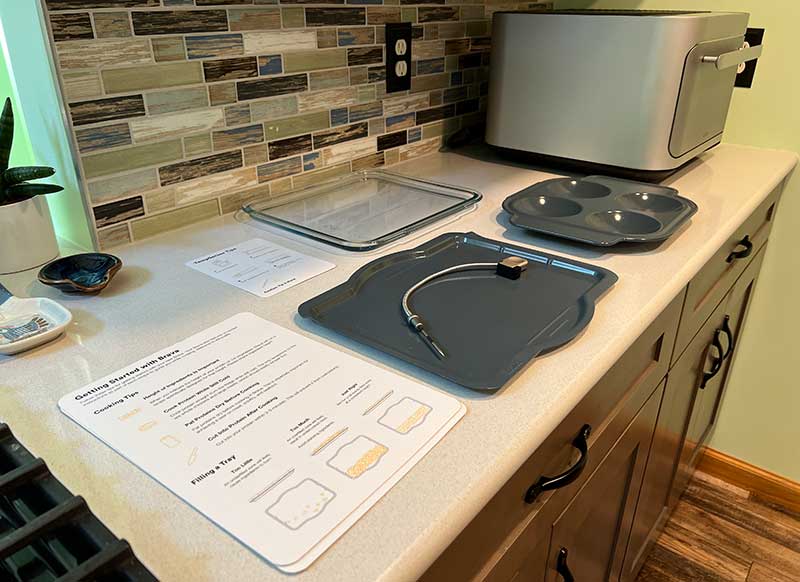
- Brava smart oven
- Glass tray
- Ceramic coated aluminum tray
- Ceramic coated aluminum egg tray
- Digital tempsensor
- Getting started guide
Note that you can buy different packages of the Brava which come with different trays. This is the configuration that was sent to me for review which is the Starter Set with an additional Egg Tray.
Hardware specs
Dimensions – Height: 11.3 inches (28.8 cm) x Width: 16.4 inches (41.6 cm) x Length: 17.3 inches (44.0 cm)
Weight – 34.4 pounds (15.6 kg)
Heating Element – 270mm crystal bulb, Full power in <1 second
Power – 1,800 Watts, 120 Volts
Processor – Quad-core ARM Cortex A53 processor with Mali T400-MP2 GPU
8GiB eMMC flash storage, 1GiB LPDDR3 RAM
Display – Multi-Touch with IPS technology
5.0-inch (diagonal) TFT-LCD display, 854×480 native resolution with up to 16.7M colors
180° viewing angle
Connectivity – Integrated Wi-Fi supporting IEEE802.11 a/b/g/n 2.4GHz/5GH
Bluetooth enabled
Camera – 5 megapixel, ultra wide angle
Design and features
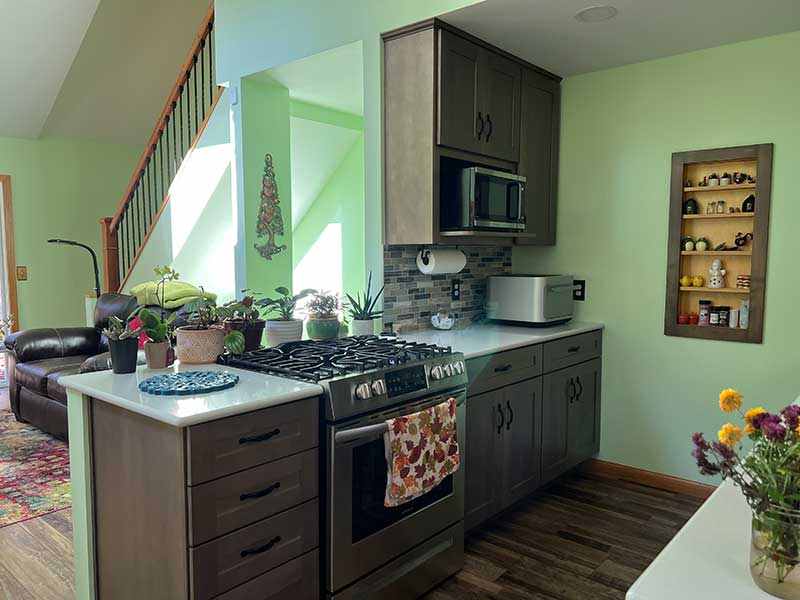
The Brava oven has the footprint of a small microwave and is designed to sit on your kitchen counter and it plugs into a standard 3-prong outlet.
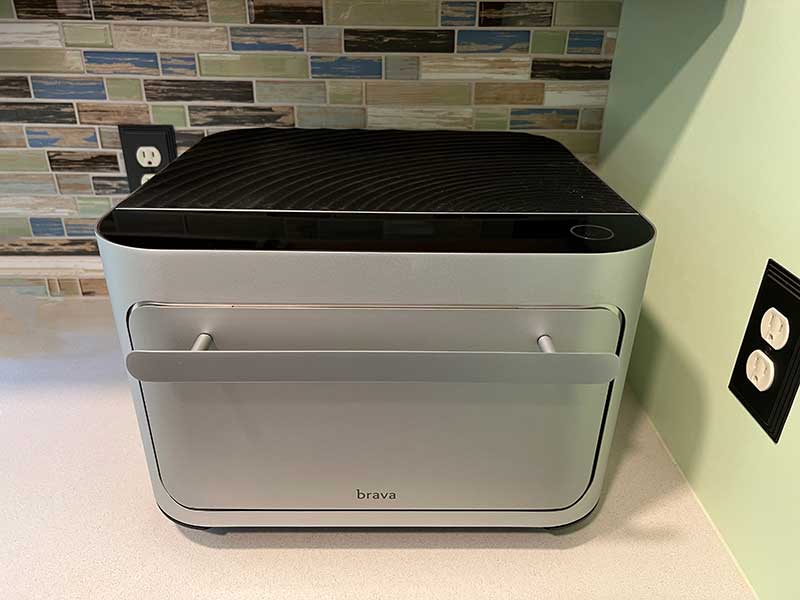
The Brava has a brushed metal case that is available in silver, red, or black. It has a modern style without being too futuristic-looking. It will fit into almost any decor including my kitchen which is a kind of modern farmhouse style.
On the front of the Brava oven, you’ll find the door which has a nice large handle.
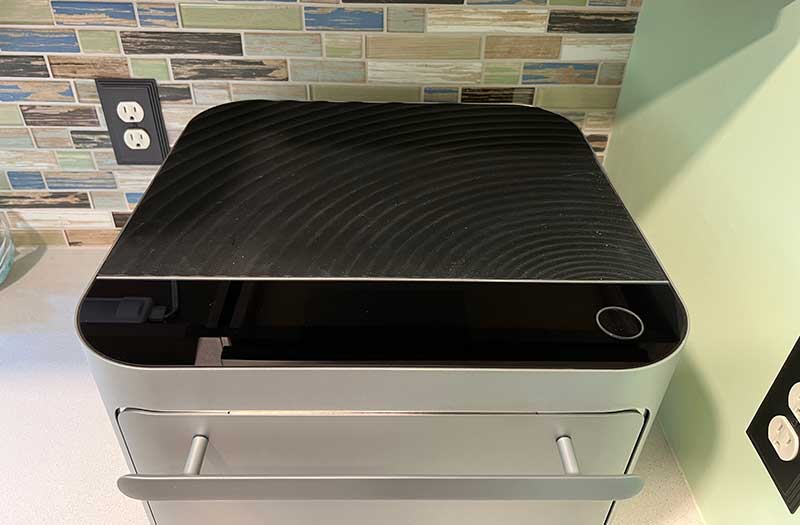
The top surface has a black silicone mat that you can use as a hot pad to place the tray when you remove it from the oven.
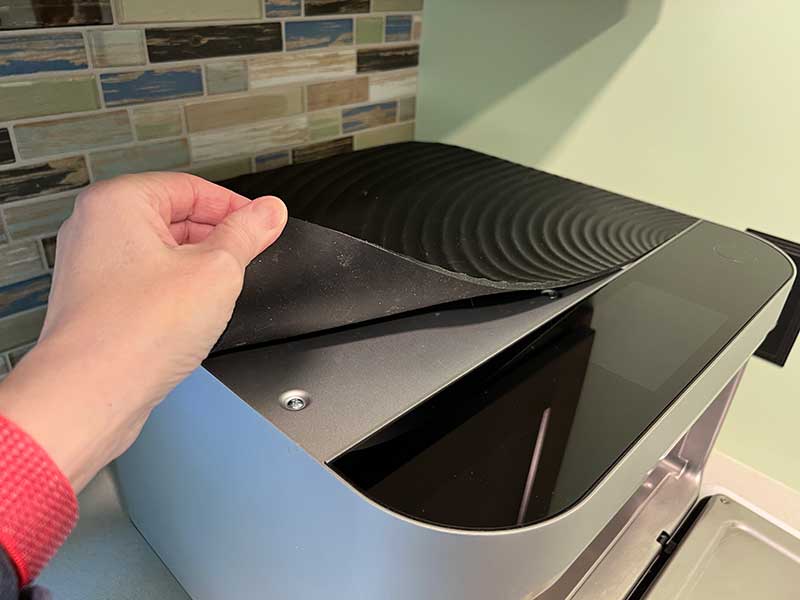
The mat is removable and washable.
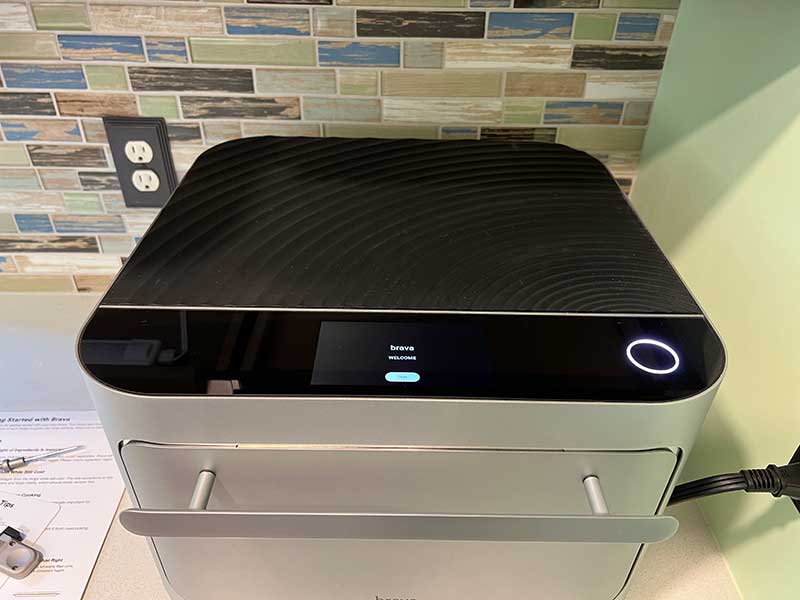
There’s also the touchscreen user interface and the control button along the front edge of the oven but more about them later.
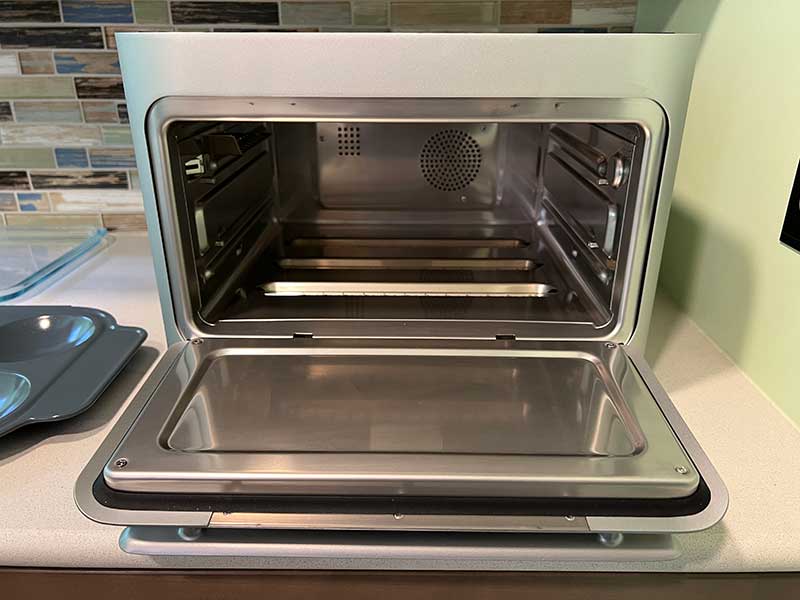
The interior of the Brava oven is all stainless steel and has a lower and upper slot for the included trays.
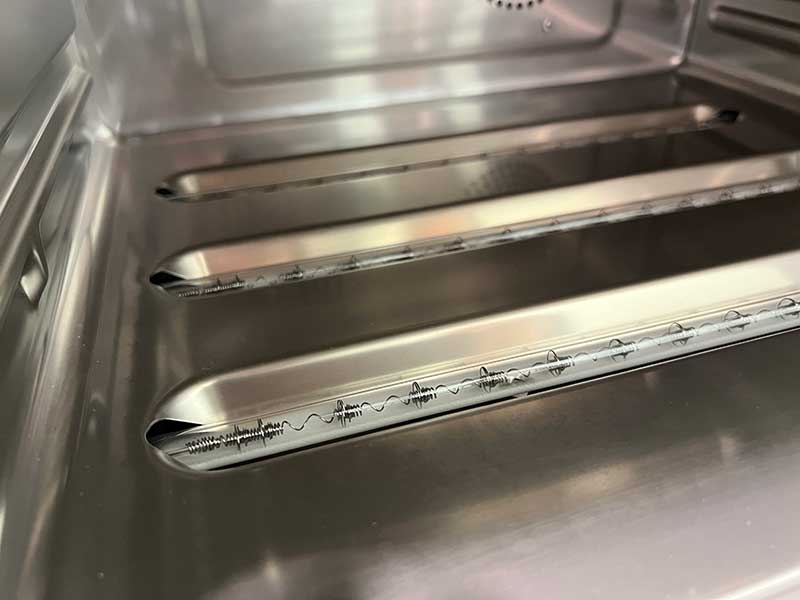
There are three long halogen light bulbs on the bottom of the oven and three more on the top/roof of the oven. Each light corresponds to the cooking zone so that the oven can cook completely different foods on the same tray.
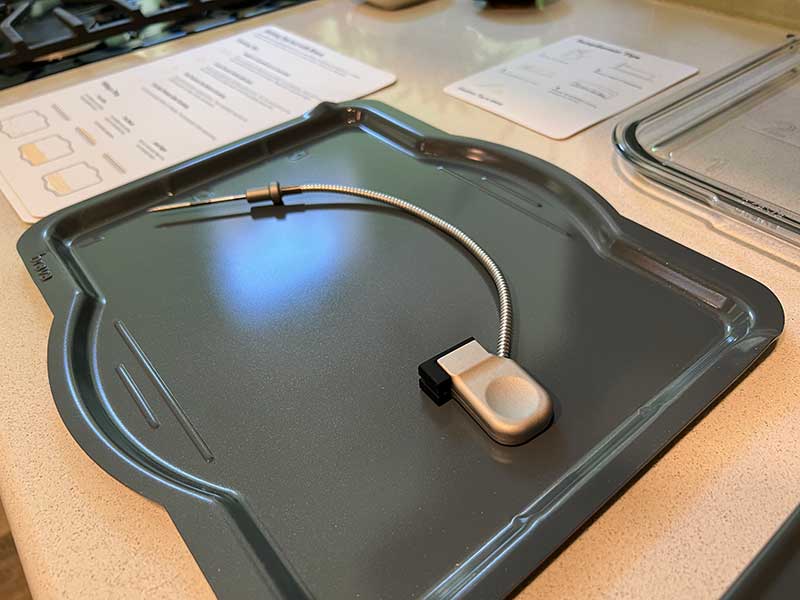
Brava includes a digital tempsensor that ensures that your foods (proteins) are cooked to your exact preference – rare, medium rare, medium well, well done. You decide and Brave does your bidding!
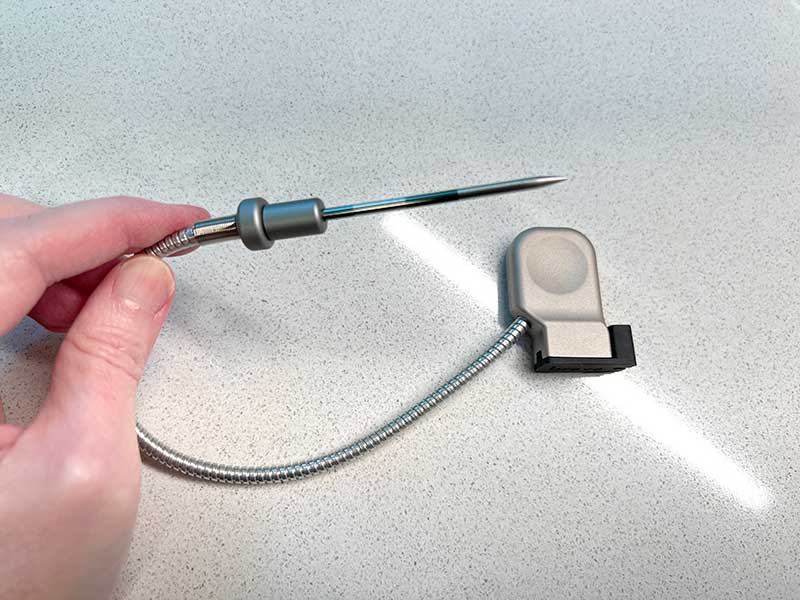
The tip of the tempsensor has marks that allow it to double as a measuring device so that you can input the thickness of the protein into the cook specs to let Brava figure out how long and how hot to cook the food.
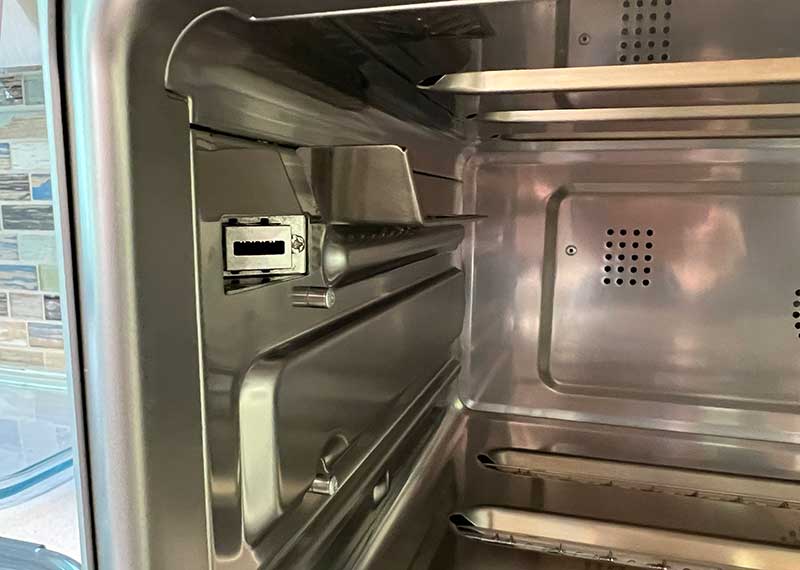
The tempsensor plugs into the slot on the left side of the oven. It looks kind of like a USB plug but it’s not 😉
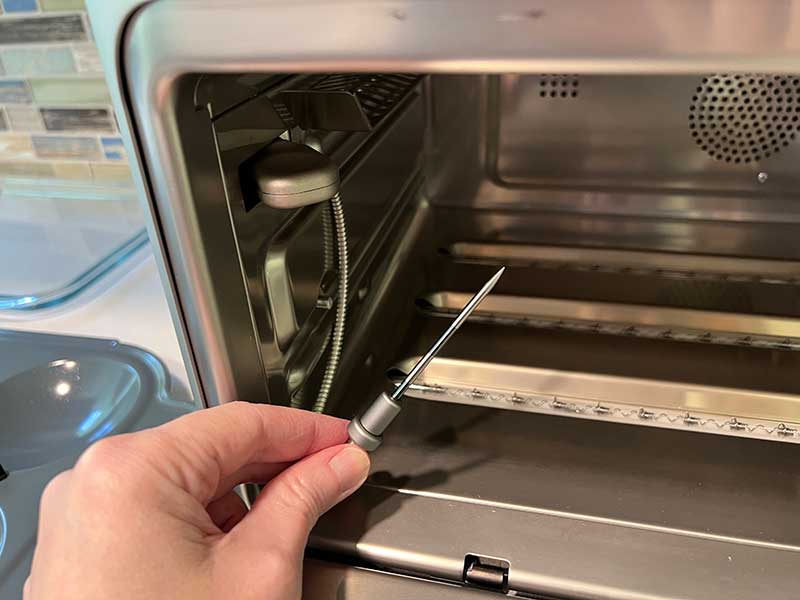
Here we see the tempsensor plugged in and ready to be used.
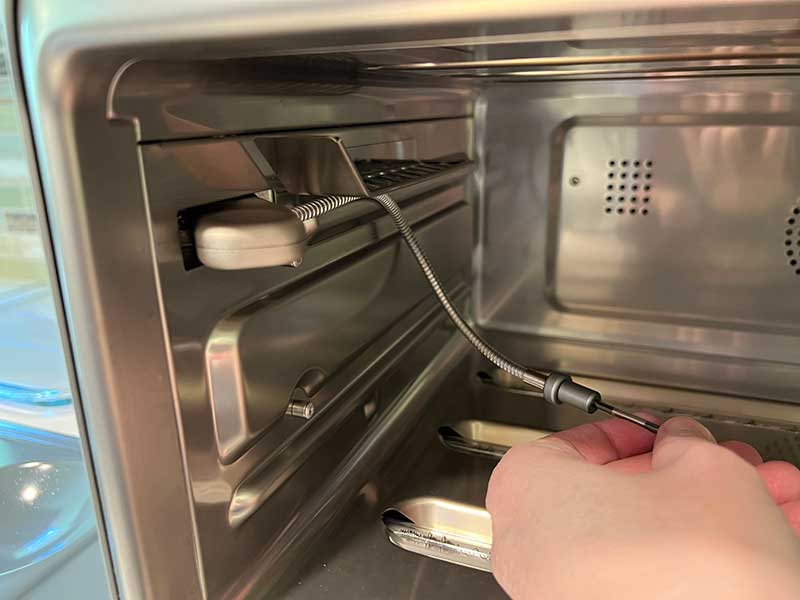
You can also see a metal guard/plate above the tempsensor connection slot. This guard protects the tempsensor’s lead from the extreme temps inside the oven.

Depending on the package, the Brava oven comes with different cooking trays or pans. Mine came with a glass tray and two ceramic coated aluminum trays. As you can see above, the glass tray has three sections or as Brava calls them, zones.
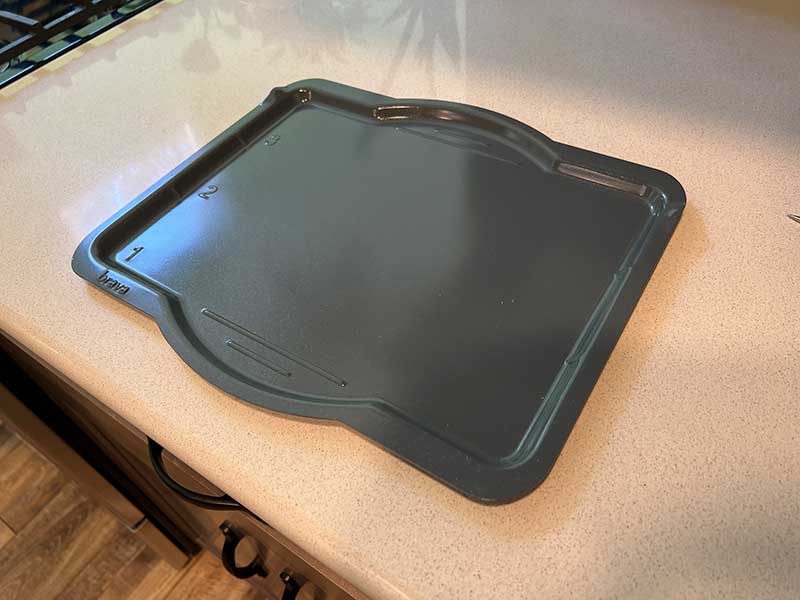
The ceramic coated aluminum tray has the same three zones. The zones will make more sense when you start cooking. So let’s do that now!
Enough talking, let’s get cooking!
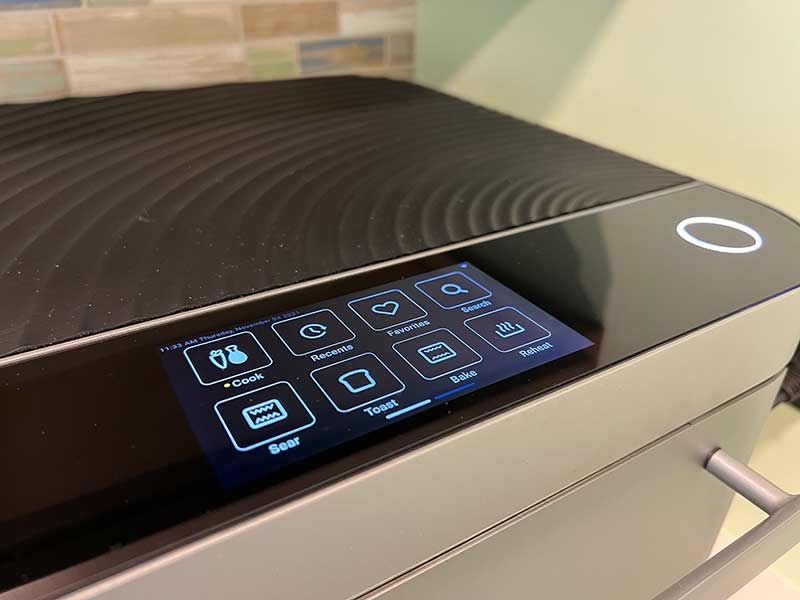
The first thing you do after you unbox the Brava and plug it in is to follow the onscreen prompts to connect it to the internet. It will then prompt to update the firmware if needed. Once everything is updated, you’ll see the main menu that is shown above. The menu is two pages long and lets you choose from options like cook, sear, toast, bake, reheat, slow cook, warmer, and more. There is also an option to see recent recipes, favorites, and search.
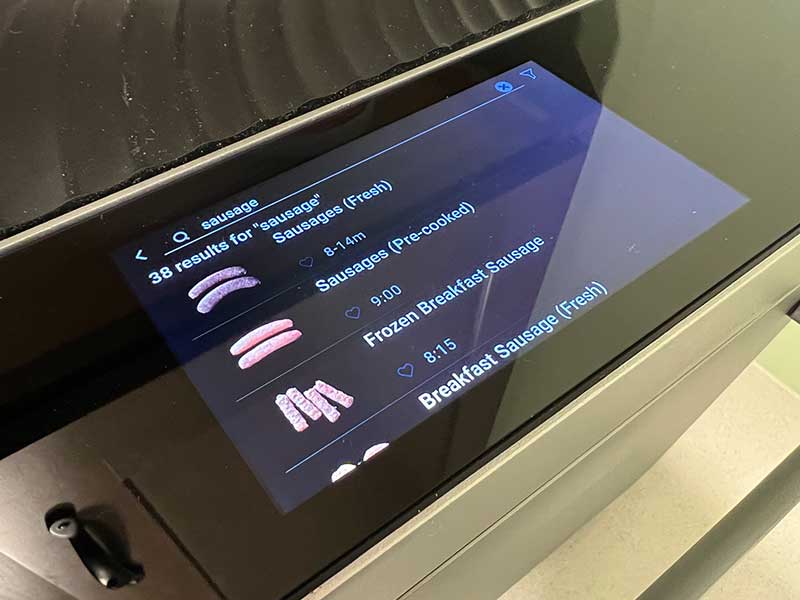
I picked something very easy for my first test of the Brava. Sausage links! So I used the search feature and used the touchscreen to type sausage in the search field. I was presented with quite a few options.
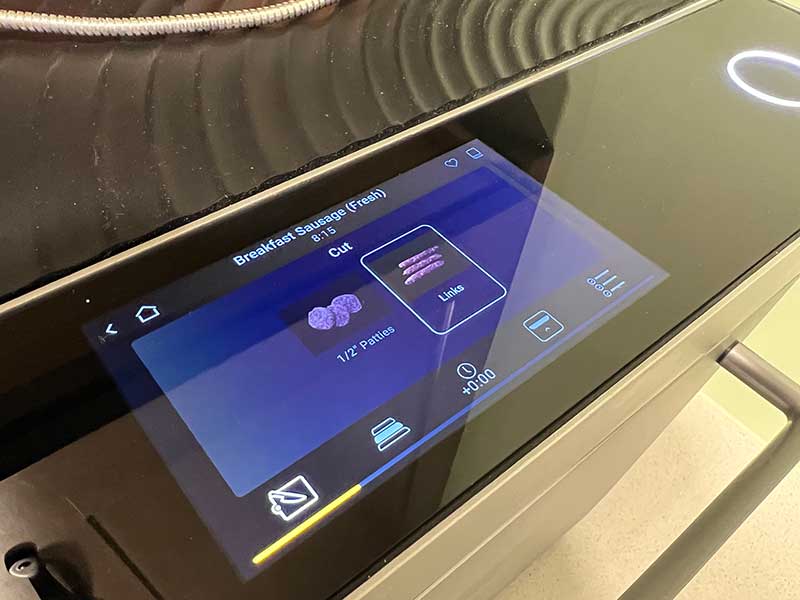
I went with the fresh links option.
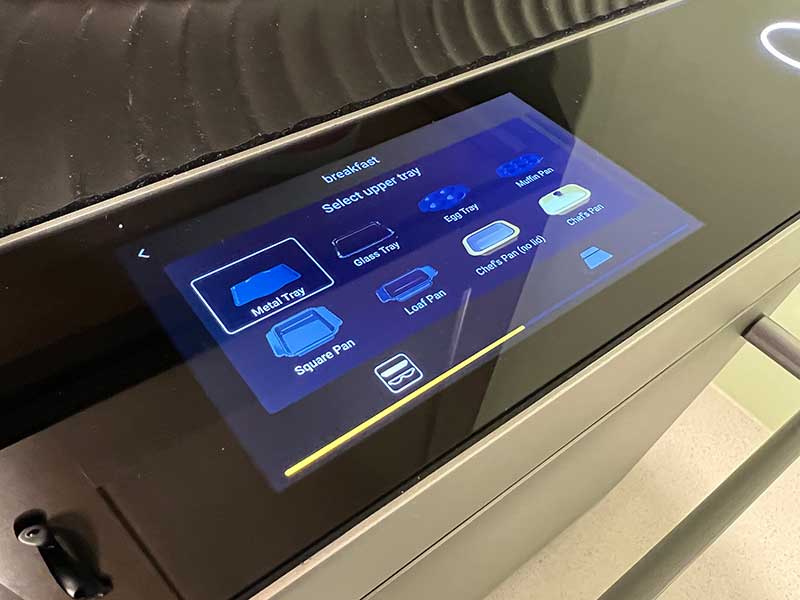
Brava tells you exactly what to do step by step. I washed the metal tray…
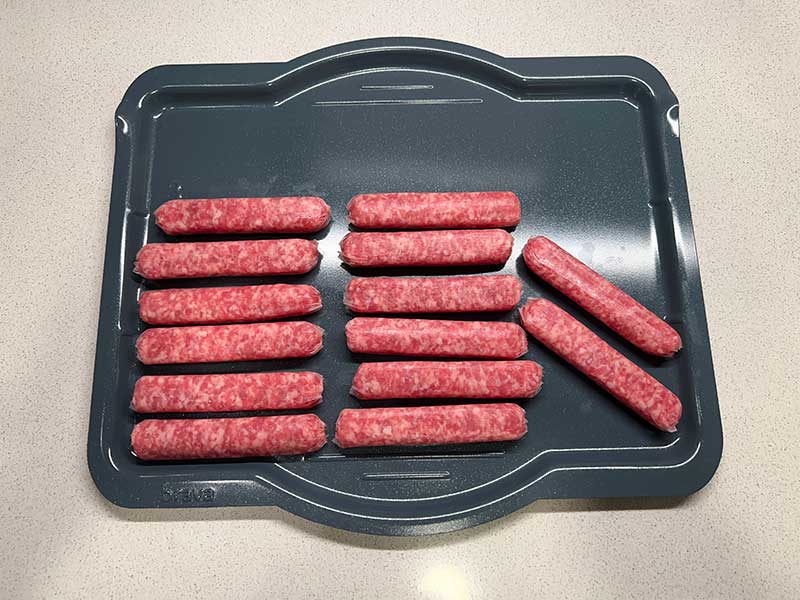
Opened the package, arranged the links.
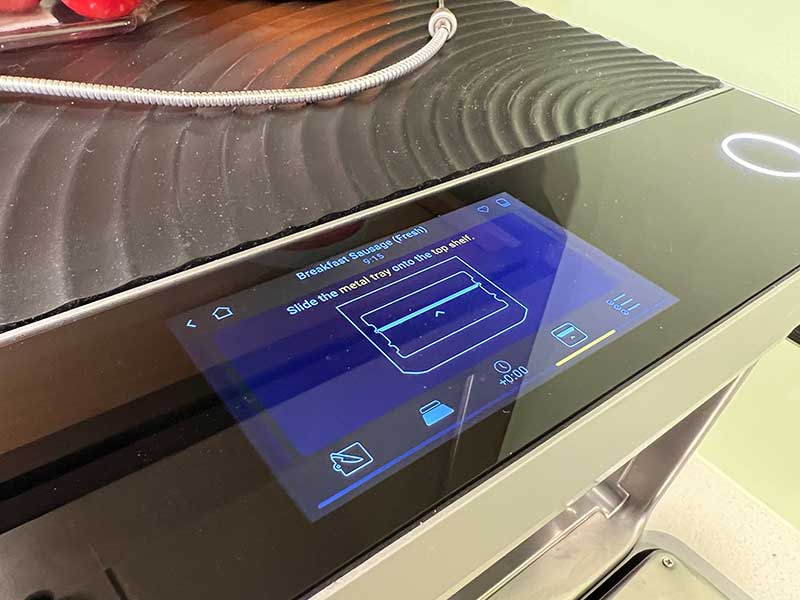
It tells me to put the tray on the top shelf…
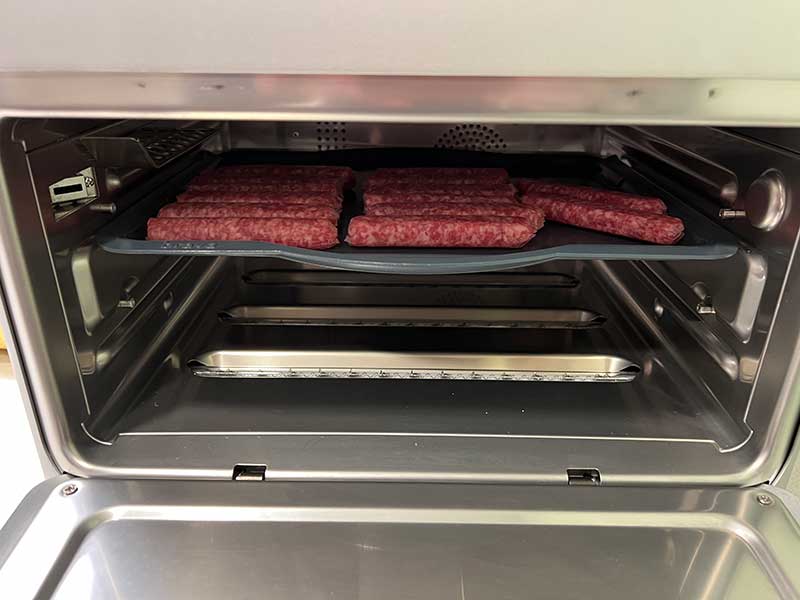
Which I do.
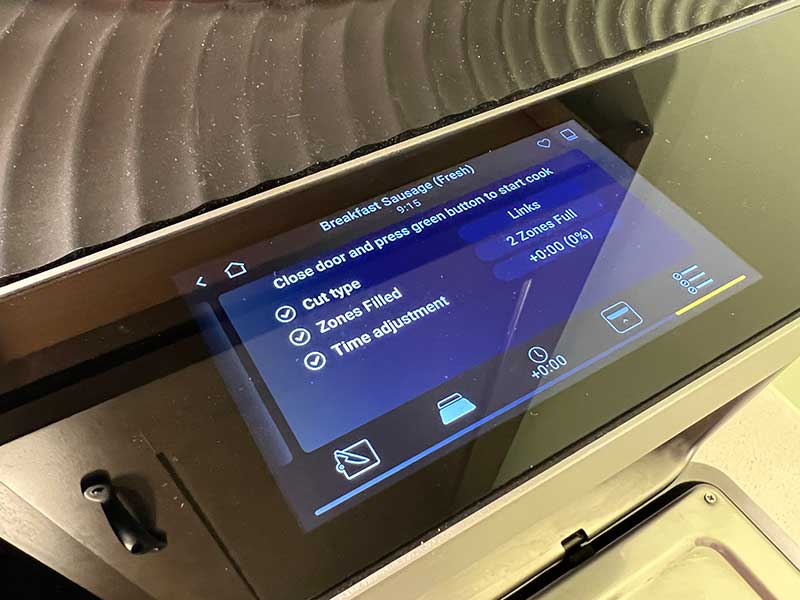
It then shows me a summary.
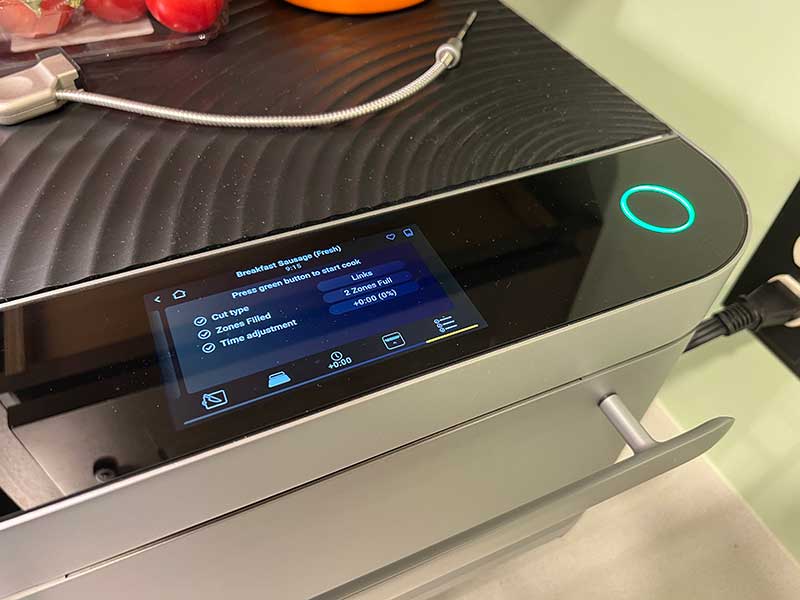
If everything looks good, you press the button, and cooking starts! The status LED around the button turns red to let you know that it’s cooking but you’ll also see a live view on the display because…
Brava even has a built-in camera!
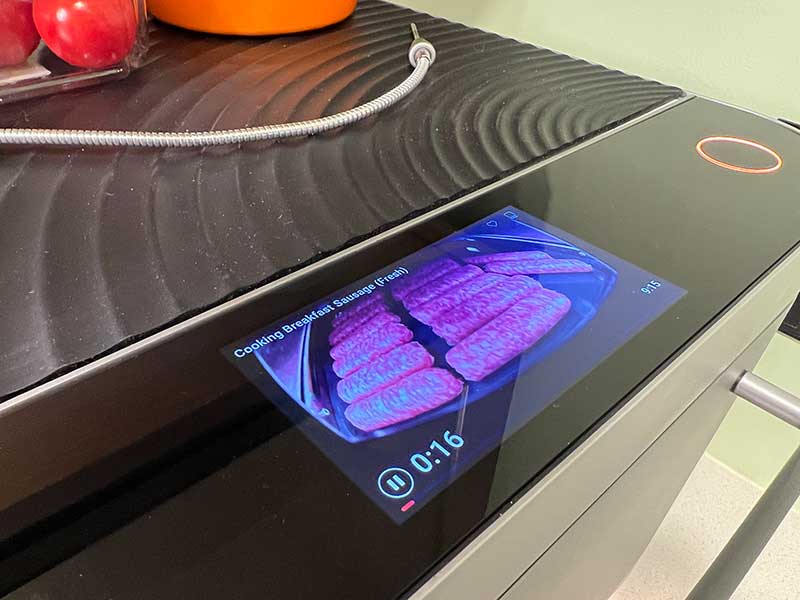
How cool is that? But it gets even better because the Brava mobile app also shows you a view from the camera inside the oven.
Being able to see what’s going on in the oven from the app means that you don’t have to be in the kitchen while it’s cooking. You can be in another part of the house and still be able to check in on your food.
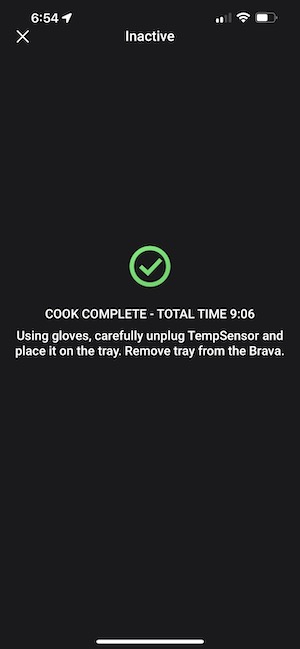
The app will also tell you when the cooking session has ended. Let’s go check our sausages!
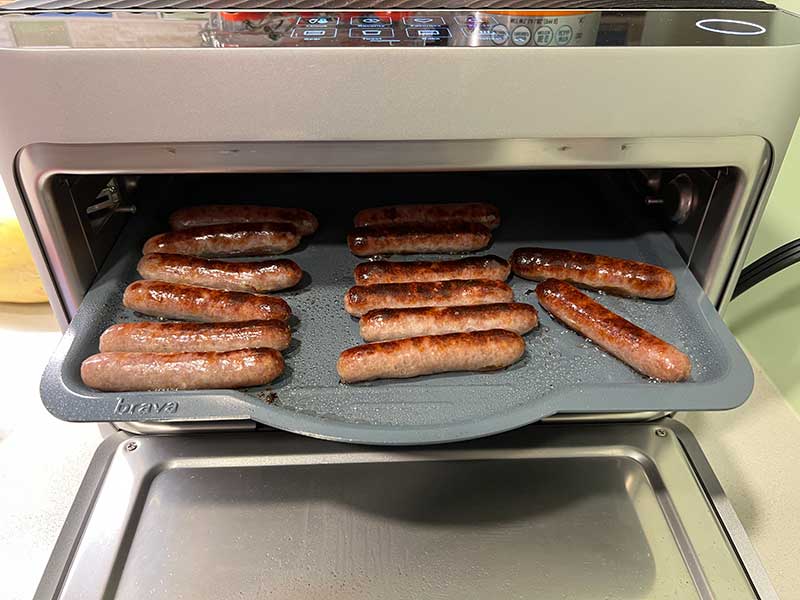
Perfect links in 9 minutes. Nice!
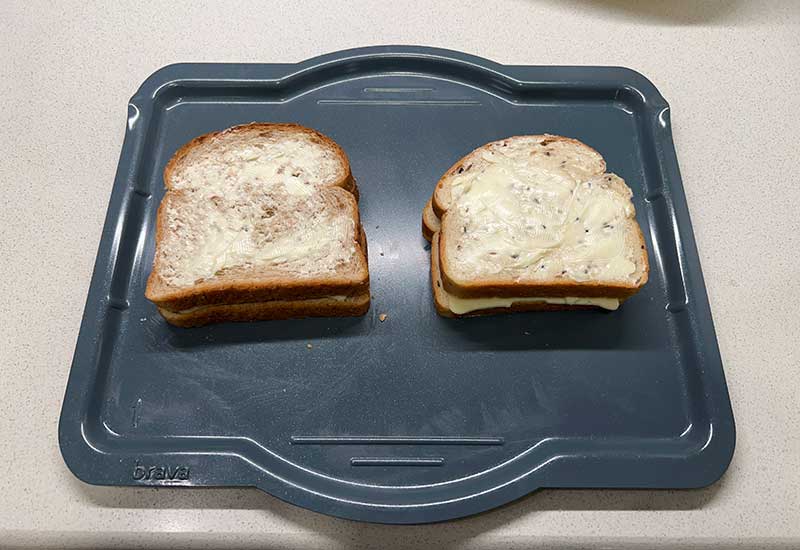
For my next test, I went easy again with grilled cheese sandwiches.
I used the Toast menu function which lets you choose your preferred toast level.

Brava shows that I’ll have sandwiches in five minutes.
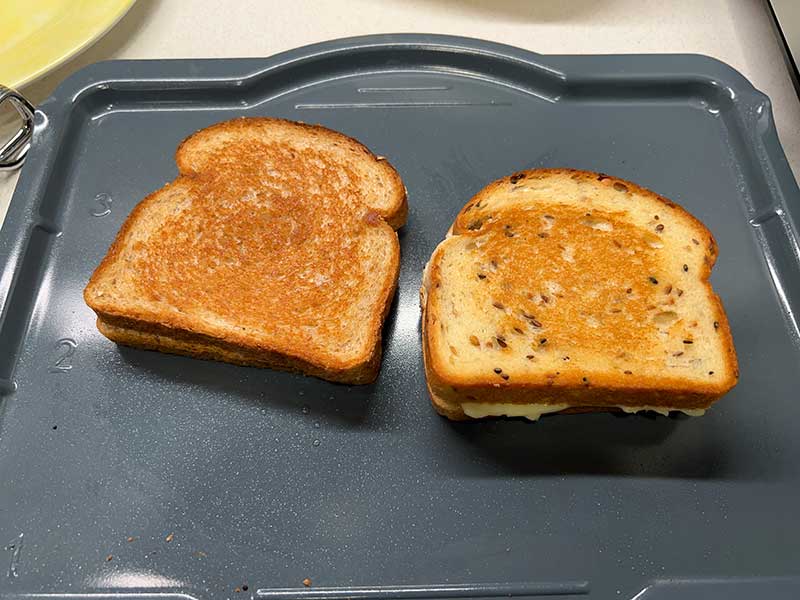
So five minutes later, I have perfectly grilled (toasted) cheese sandwiches and I didn’t even have to flip them!
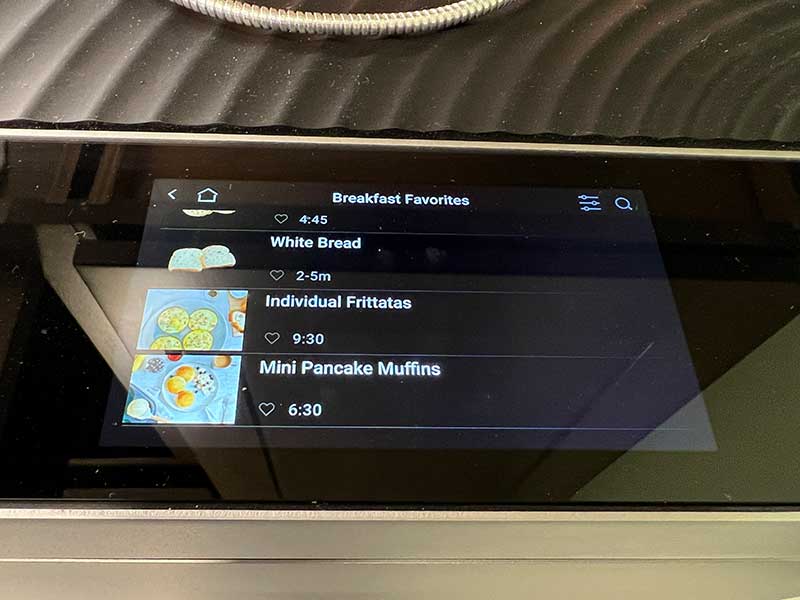
It was time to get a little bit fancier with egg frittatas!
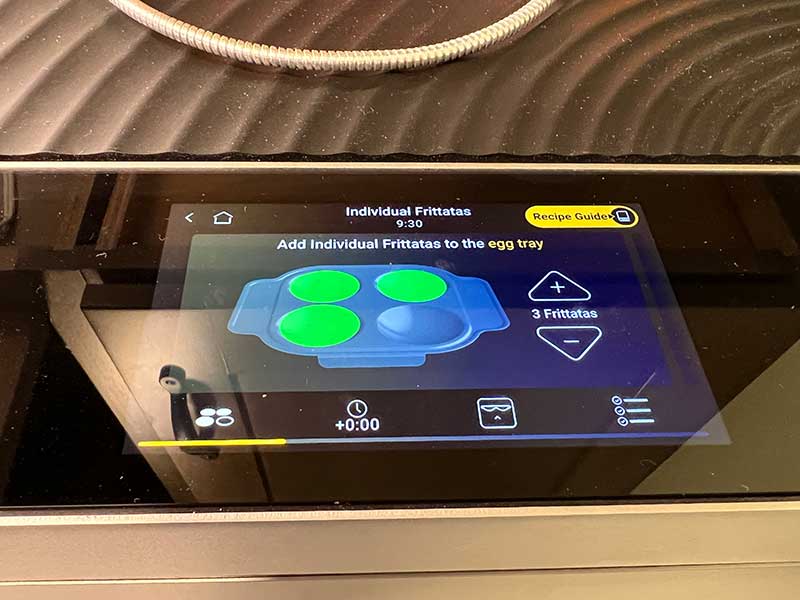
It lets you choose how many you want to make.
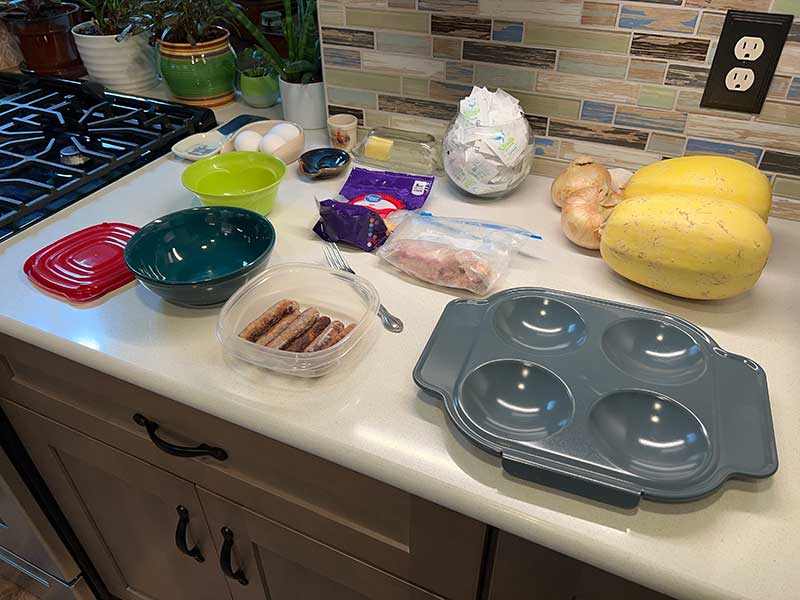
My frittata station included three 3 eggs, leftover sausage links, leftover bacon, cheese, salt, and pepper.
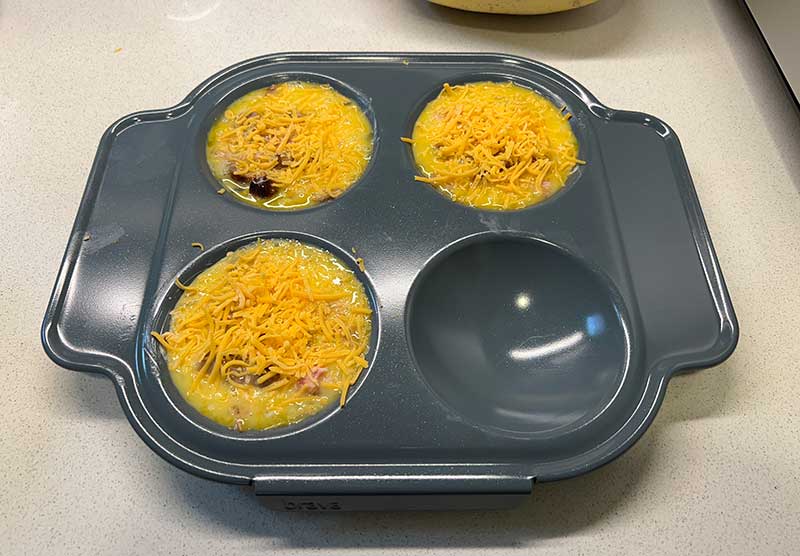
Ready to cook…
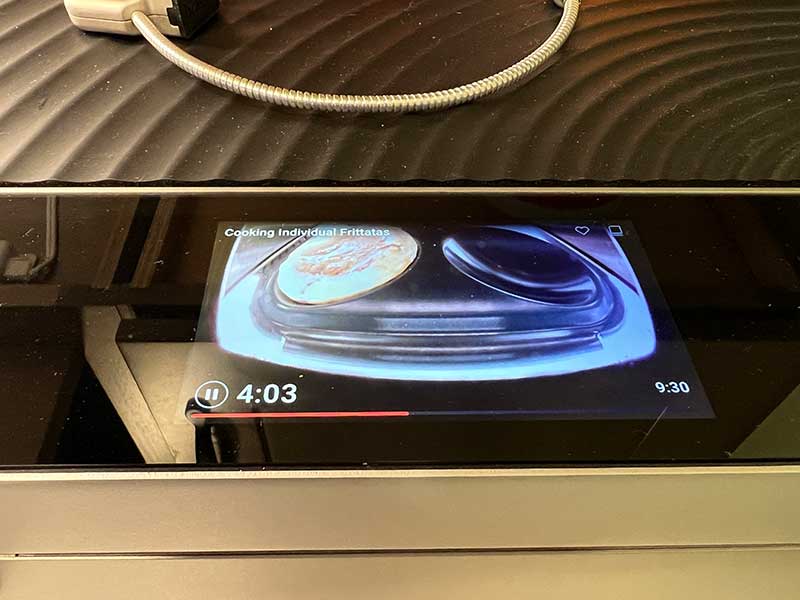
This time I didn’t like the length of time the oven had chosen because I could see that the frittatas were getting a little brown on top and I don’t like overcooked eggs so I was able to press the Pause button on the screen to stop the cook.
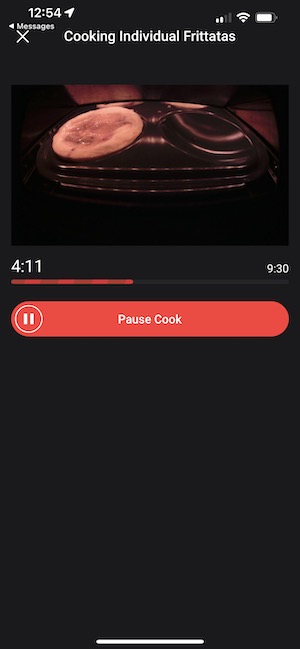
I could see and do the same thing through the Brava app.
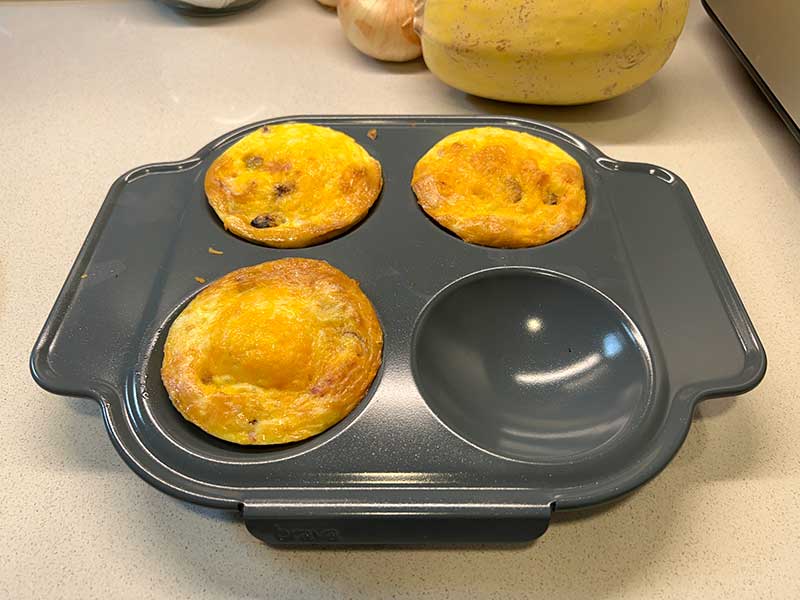
Yum!
I also used the Brava Oven instead of my microwave to reheat leftovers and I liked how the texture and taste were like freshly prepared food instead of rubbery or hard like can sometimes happen in a microwave.
Next up was my most ambitious test… a combo meal with two completely different types of foods that would require completely different cooking times/heat. But that’s what makes the Brava so great. It can do that with no problem because it can turn the lights off and on individually for each zone.
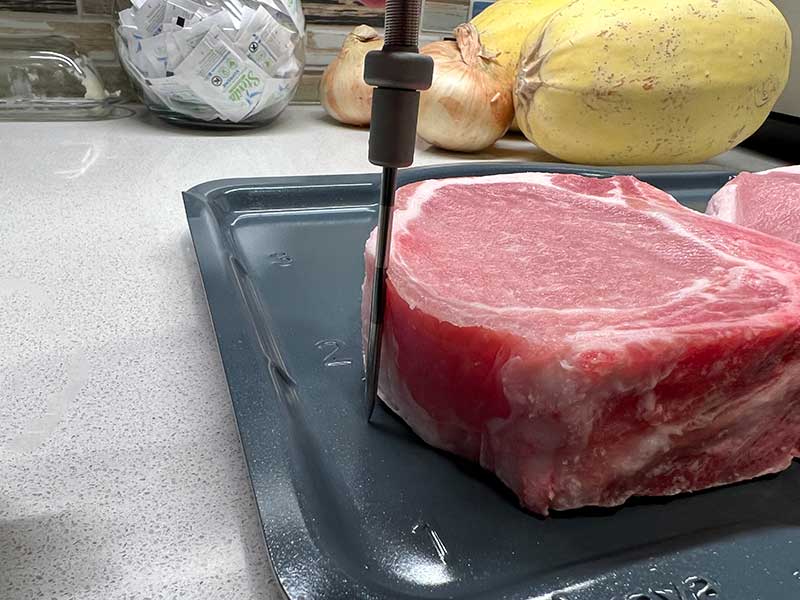
I decided on pork chops and Brussel sprouts. For this cook, the tempsensor is required. Brava instructs me to tell it how thick the chops are which is easy to do because the sensor has markings on it.
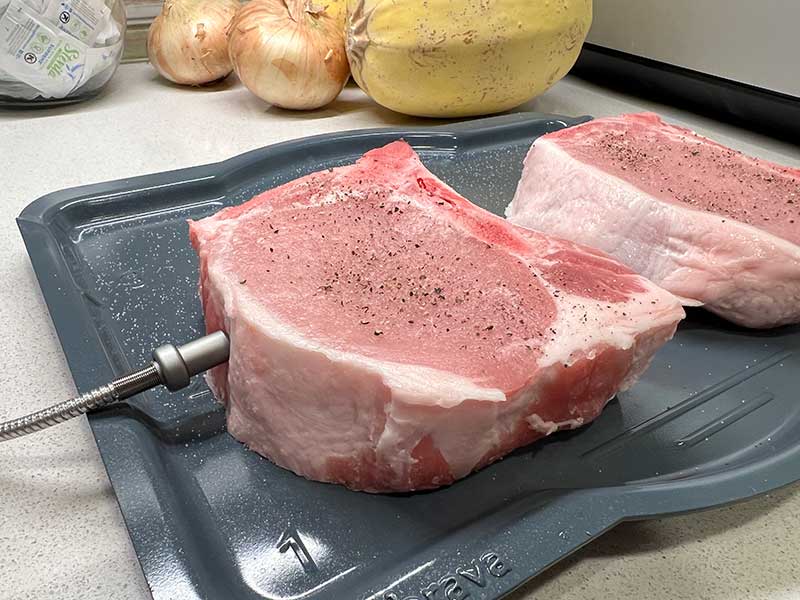
The sensor goes into the fattest part of the meat on the left side.
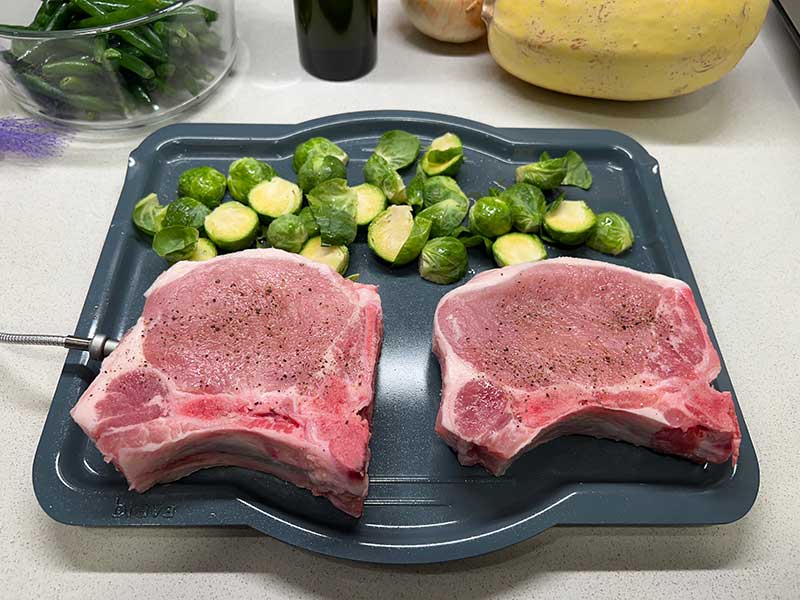
I halved Brussel sprouts and tossed them with a little bit of olive oil, salt, and pepper.

The metal tray then goes into the oven on the top shelf and the tempsensor is plugged in with the cable under the protective shield.
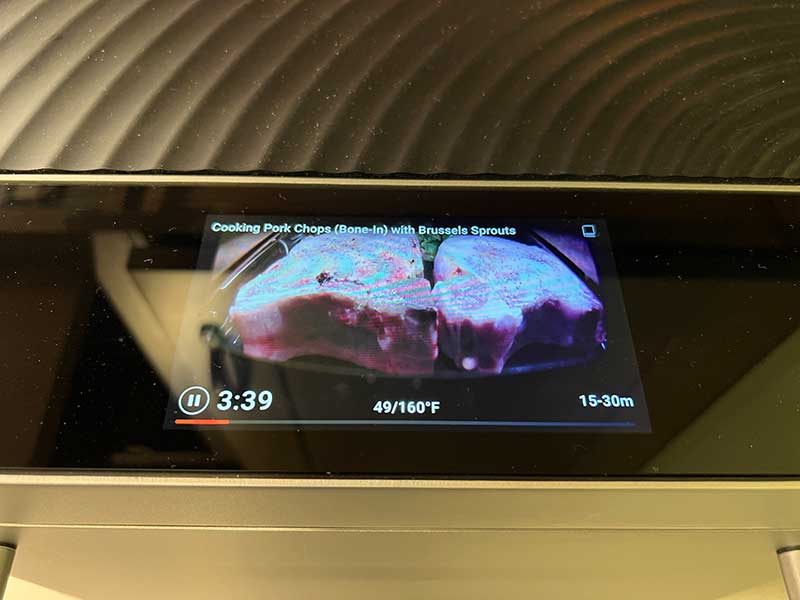
The real-time display shows the time left and a live readout of the tempsensor.
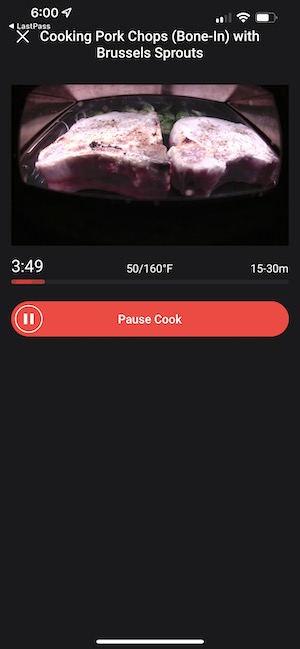
Again, you can see the same info through the Brava app if you don’t want to hang out in the kitchen while it’s cooking.
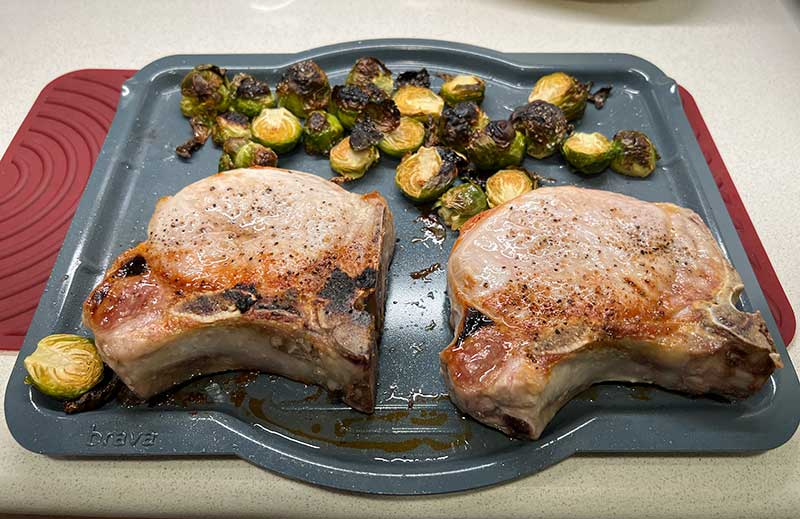
When the meat has reached the desired temperature, the oven will beep to let you know that the cook has completed. The app will notify you too. Wow, how great does that meal look? Looks can be deceiving though…
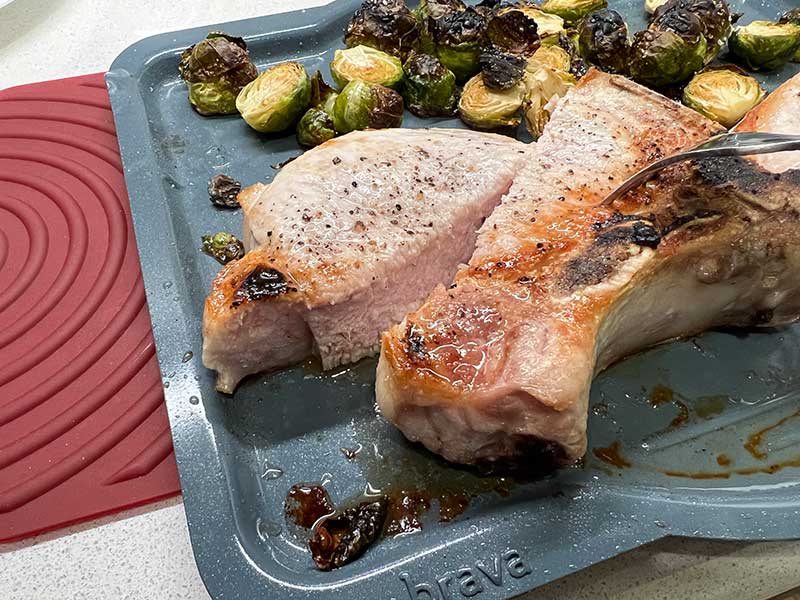
I’ve cooked a lot of pork chops in my life and it’s not uncommon for them to end up dry. Not this time! I have to say (and I’m not exaggerating) that these pork chops were the juiciest chops and most perfectly cooked chops that I’ve had in decades. I’m serious. They were perfect. AND, the sprouts were perfectly roasted too.
Reheating one of the chops (they were so big Jeanne and I just split one) a couple of days later in the Brava Oven was like it had been freshly cooked. It was still almost as juicy as the other one.
Brava comes with 1000’s of built-in recipes
Brava makes it easy to cook your favorite foods and foods that you don’t even know are your favorites yet with the built-in recipes. Right now, there are over 6000 recipes in their database that you can find through Brava’s website, app, and the Brava search feature on the oven itself. I like using the Brava website the best just because it’s easier to see on my huge monitor hooked to my MacBook Pro! 🙂
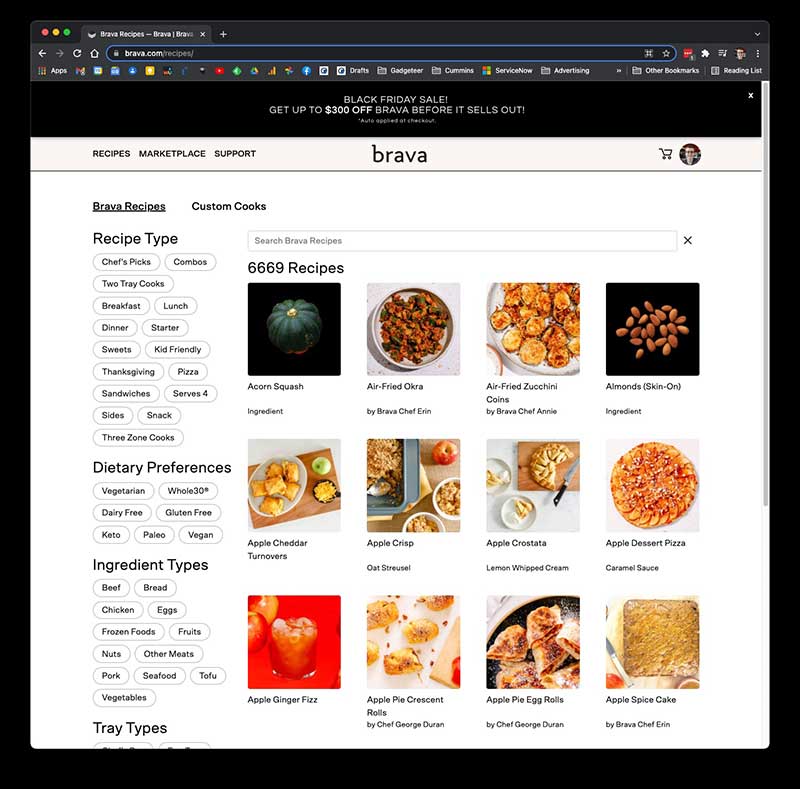
I use my laptop to browse the Brava website which allows you to easily drill down to just the recipes you’re interested in. You can even filter by diet type like Keto and by tray type or even if you want recipes that use two trays at the same time.
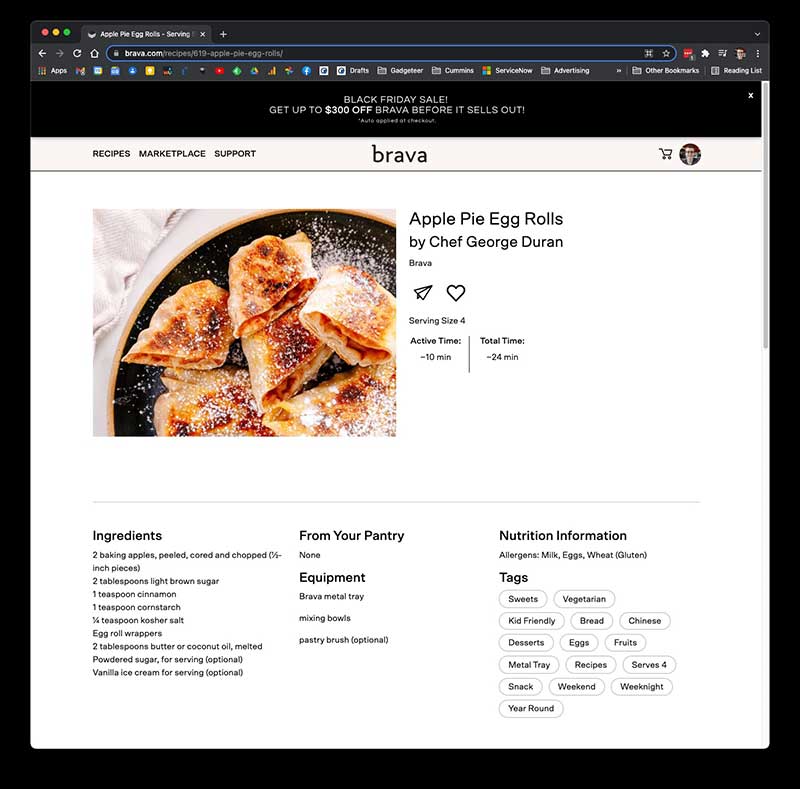
Once you find a recipe that you want to make, you can then click the little airplane icon and it will be sent to the oven and will be waiting for you right on the screen to start your step-by-step cook.
What if you can’t find a recipe and want to make your own? No problem. You can use the custom cooking option and then save the recipe to use again in the future.
Will the Brava oven still work even if your internet is down?
Yes. Keeping it connected to your WiFi is desirable for firmware updates and weekly updates to the recipes, but it’s not mandatory.
What I like
- Makes cooking fun and easy
- Built-in step-by-step recipes that are constantly updating
- Replaces a microwave, air fryer, dehydrator, and oven
What I’d change
- Additional accessories are pricey
- Add larger models for bigger families
Final thoughts
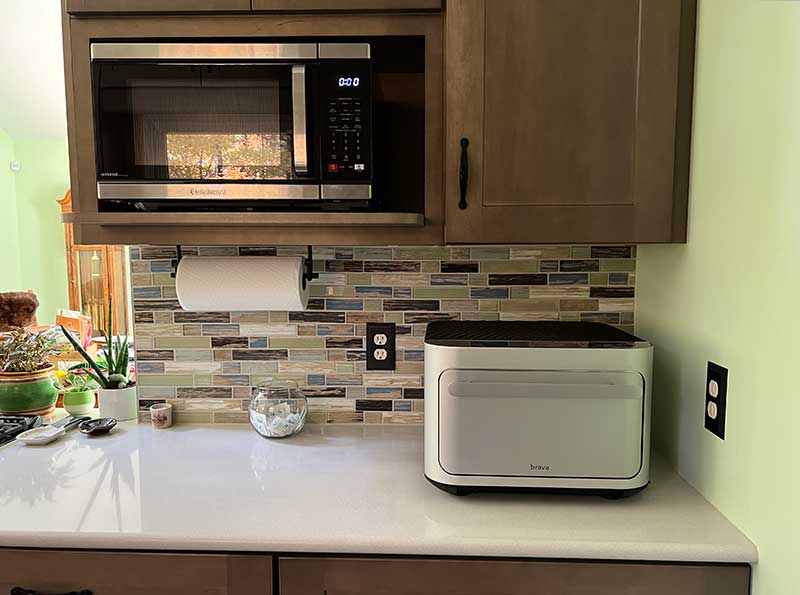
One of the main issues that I see with the Brava oven is its size. It’s small. For my family, it’s fine as there are only two of us to cook for. But for a larger family, you might need to cook in batches. I also think that for the price, that you should receive the additional trays instead of having to buy each one for $50.
I’ve only been using the Brava Oven for a few weeks, but I already find it to be one of my favorite kitchen appliances that I’ve ever reviewed. I realize that it’s an expensive purchase but the fact that it can be used instead of a microwave to reheat leftovers, an oven, an air fryer, slow cooker, and a dehydrator means that it will take up less space in your kitchen than having all of those devices. I think it would be great for someone who has a very small kitchen and who likes step-by-step instructions for cooking.
Price: $1295.00 – $1695.00
Where to buy: Brava
Source: The sample for this review was provided by Brava.



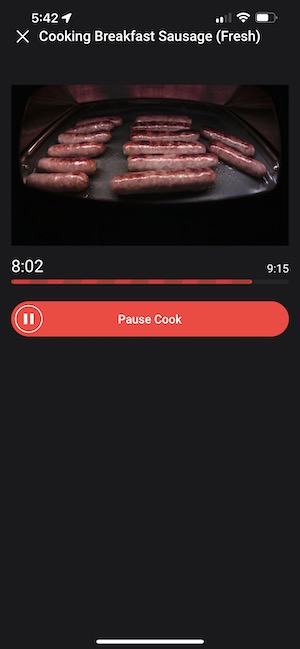


Gadgeteer Comment Policy - Please read before commenting
How much clean up of the Brava was there after cooking the sausages and pork chops?
Other than the tray? Nothing really. It’s self-cleaning. The inside of the door had some splatters, but I wiped it off with wet cloth after it was cooled down.
So this oven basically uses halogen lamps as heating elements. The light the lamps put out does none of the cooking but is the reason there is no glass window and a camera is needed instead to see the food. Why not just use ordinary heating elements and skip the camera? How easy is it to replace the lamps and how much does it cost? Halogen lamps are not known for long life and are very sensitive to even small amounts of contaminants. Touch one and the oil from your finger may cause it to shatter the next time it is turned on. I would expect the same to be true of the lamps in this oven. Bits of broken glass in your oven (and food!) does not sound good. Controlling an oven from a phone does not sound like a good idea if you have kids who play with your phone.
Ron, I asked Brava about your questions and here is their response.
More info:
Thanks for looking into this further. Here’s a fairly long reply outlining why I still think halogen lamps are a bad idea for use in an oven. I’m basing my thoughts on my background in physics (B.A. in physics) and electronics (20+ years of professional experience.)
Heating elements also output infrared light, heat is infrared radiation, it is light, so I still don’t see any difference between using heating elements and halogen lights except that the halogen lights are more fragile and they turn a very small amount of the electricity into visible light (which does no cooking). The reason you can feel heat from any heating element at a distance is not because it heats the air (although that happens also), it is because heat is IR radiation and it radiates through space from the heating element. IR radiation is considered a form of light, so heating elements put out IR light. Halogen lights convert 99% of the power going through them to IR radiation, i.e., heat, and only 1% to visible light. This is why they get really really hot. So this sounds like a marketing ploy, to use halogen lamps and call it “infrared light” when in fact every type of heating element puts out IR light. People are used to thinking of central air heating in their home as hot air, but somewhere that air is being exposed to IR light (in the furnace). Hot water systems pump hot water through radiators and the radiators emit IR light. Unless the halogen lamps put out a specific frequency of IR light they are no different than normal heating elements. But they do not, they just get hot and put out heat in the normal spectrum, same as a heating element. If they put out some special tailored IR frequency they would cost hundreds of dollars each. They are just ordinary halogen lamps being used as heating elements. The visible light they output is more of a bother than a feature and is why they don’t have a window on the front (because you’d have 2000+ watts of white light shining into your kitchen which would be annoying, perhaps even blinding.)
However, focused IR light is perhaps a more direct way to get heat to food. In an ordinary oven the heating elements do mainly heat the oven air and the oven interior, and then the air and metal surfaces radiate IR light. They don’t have to be designed this way, the heating elements could heat the food directly (and in some cases do, like the upper elements in a toaster oven that toast bread by radiating heat directly to the bread). The reason that ovens isolate the bottom heating coils (under a metal plate) is because direct IR radiation tends to heat ONLY where it hits the food. If you stand next to a bonfire your front gets warm but your back stays cold. Thus your toaster oven will only toast your bread on the top (unless you remove the bottom metal pan). And it will only heat were it illuminates the food, so the sides of your bread will not get toasted, just the top and bottom. Heating the air instead surrounds the food in IR radiation and thus heats the food more evenly and thoroughly. I suspect a halogen IR light oven will burn foods more easily and cook food less evenly because the radiation goes directly to the food (and not to the sides away from the lights). However, halogen lights get hot, the food gets hot, the metal or glass tray gets hot, so the oven air will eventually also get hot, cooking the food more evenly. Is there a fan? If so it is there to heat the air more evenly because that is what is doing the cooking! So at best I could see a halogen light based oven doing browning better (and hence also doing burning better) and cooking food less evenly, but you could get the same effect from a normal oven by just removing the bottom metal pan. Notice also that when you use a metal pan (or the glass one, glass is not transparent to IR light) the bottom halogen IR light never hits the food directly; it is instead heating the air and pan, just like a conventional oven! Heating elements start emitting IR light just as fast as halogen lamps do. And these lower lights are the ones that are on the most. In your photos of the sausage links cooking note that the photos only show the top halogen lights turned on only in the first picture, for a short time. They are turned off after a while so they don’t burn the food (after browning it) and most of the cooking is done with heat rising from below, exactly like an ordinary oven! Maybe the oven can cook faster because it gets hotter and it times the cooking more precisely (hence the use of the thermometer), but it is not faster because it uses “IR light”. More likely it is faster because it is small and doesn’t take as long to heat up the interior air. It takes a long time to preheat a full size oven and I suspect that is where they get their “2x-4x faster” claims from. It also cooks foods on all sides at the same time so it is faster than using a frying pan. Most any toaster oven could make the same claims.
I still think the halogen bulbs are likely to shatter at some point, it is very difficult to keep spatters away from anything inside an oven. The top halogen lights are not protected by a metal cover so oil spatters from cooking sausages are likely to reach these lights and could cause them to shatter (also the spatters are likely to burn and create smoke when the upper halogen lights turn on again, but all ovens tend to create some smoke.) Even if touching the lamps with your fingers is unlikely, food spatters or vaporized oil are likely to reach the lamps and shorten their life. Shattering is a known failure mode of halogen lamps (they are made of high temperature glass and get very hot) so it will happen for some people. Key to causing shattering is temperature differentials, one part of the bulb gets hotter than another part. This can be caused by a fingerprint, but also by any other contaminant like oil or bits of food that explode from water boiling inside them. Normal heating elements do not shatter. People often clean ovens, so imagine corrosive oven cleaner being scrubbed onto the lamps. If you never touch the lamps you can never clean them (to some extent they get so hot they are self cleaning though). A note above says the lamps are indeed user replaceable, which is good.
So the use of halogen lights as a heat source still seems like a marketing ploy to me, and is not likely to cook food any faster or more efficiently. You don’t get energy for free and the thermal mass of the food combined with the heat output of the lamps or heating elements is what determines cooking speed, not the fact that halogen lamps are used. The small size of the oven is more likely to be what improves heating time and perhaps it has better than ordinary insulation.
It’s good the oven can not be turned on from the phone, requiring a manual start is a good feature.
Maybe after you’ve had the oven for a year or two you can do a followup report on whether there have been any issues. In fact, that could be a valuable feature for all your reviews, adding a followup after you’ve lived with the gadgets for a while. It could almost double the number of articles on your blog as well. I like the blog, just thought I had to comment on what seems to be a marketing ploy rather than real science.
Most of the cost of this oven is in the camera, wireless connection and built in computer, all of which would not be needed if the lights were not so bright that a glass window can’t be used. Still being able to remotely check on cooking has some value.
Julie, this is an interesting appliance (we don’t use our microwave very much for a variety of reasons). If I were to replace our microwave it would be desirable to locate the Brava in the same space for a couple of reasons: electrical is already there, and wouldn’t take up counter space. However, it appears to require good ventilation, and a DEDICATED 20a circuit. Did you find either of those as limitations when you’re using the product?
Michael, I was very worried about the dedicated circuit requirement when I agreed to do the review. But the PR person said that she has no issues using it in her kitchen so I went ahead and accepted. I have had no issues using the Brava while the microwave and gas stove are being used all at the same time. As for locating the Brava oven in the same space as a microwave, I wanted to do that too. As you can see in my review pictures, I have a microwave mounted in a cabinet. The Brava would fit there just fine BUT, the controls are on the top surface and unless I grew about 3 feet taller, I’d not be able to access them 😉 I have the oven about 4 inches from two walls and have felt around it when it’s cooking and haven’t felt any heat at all. Everything remains cool to the touch.